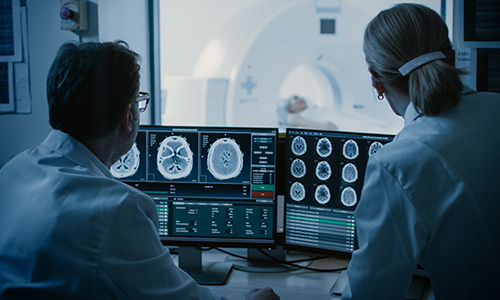

Neurointerventional surgery is a relatively new subspecialty of radiology that offers minimally invasive alternatives to traditional open surgical procedures. Physicians who perform these procedures are called neurointerventionalists. By harnessing the power of medical imaging to see inside the body in real time, neurointerventionalists are able to treat a variety of abnormalities of the brain, head, neck, and spine with a faster recovery time, minimal patient discomfort, and a reduced hospital stay.
If you are a patient, the descriptions of the highly specific neurointerventional procedures listed below may include terminology that is unfamiliar to you. Our subspecialty physicians can work with you or your doctor to ensure that you fully understand your diagnostic or treatment procedure, know how to prepare for it, and know what to expect.
Diagnostic Services – diagnosis of neurovascular disorders using high definition real-time/time-resolved imaging with or without provocative maneuvers.
Acute Stroke Therapy (Mechanical Thrombectomy) – using cutting-edge technology to remove emboli from the intra-cranial or extra-cranial circulation (techniques include suction embolectomy, stent-retrieval devices, and/or balloon angioplasty and stenting) and restore blood flow to the brain.
Aneurysm Treatment – full angiographic evaluation of aneurysms, followed by coordination with a multi-specialty team to determine the most appropriate course of treatment. In most cases, the aneurysm can then be treated with cutting-edge technology (including coils, stents, balloons, and flow diversion) and novel, minimally invasive techniques.
Arteriovenous Malformation (AVM) Diagnosis and Treatment – angiographic grading of an AVM, followed by coordination with a multi-specialty team to determine the most appropriate course of treatment.
Dural Arteriovenous Fistula Diagnosis and Treatment – minimally invasive techniques using angiography to diagnose and treat dural AVFs.
Epistaxis Embolization – temporary embolization to prevent further bleeding for uncontrolled posterior nosebleeds.
Spinal Arteriovenous Malformations – angiography diagnosis of spinal AVMs, followed by coordination with a multispecialty team to determine the most appropriate course of treatment.
Pseudotumor Evaluation and Stenting – recent literature suggests that bilateral transverse sinus stenoses can contribute to elevated intracranial pressure. Neurointerventionalists use angiography and venography to identify and evaluate these stenoses. In carefully selected patients, transverse venous sinus stenting can be an alternative to medical therapy or shunting.
Tumor Embolization – using angiography to identify the blood supply to a tumor and embolize the tumor prior to surgery to improve visualization and provide better outcomes with decreased risk to the patient.
Vertebral Augmentation – fluoroscopically guided vertebral augmentation (vertebroplasty) for the treatment of osteoporotic spine fractures in appropriately selected patients.
843. 692. 0570 • 1303 Azalea Ct. • Ste. B • Myrtle Beach, SC 29577
© 2025 Carolina Radiology • Web Design by Three Ring Focus • Privacy / Terms / Employment